In today’s digital landscape, newsletters have become an essential tool for businesses and organizations to connect with their audience, share valuable information, and drive engagement. As a seasoned marketer, I have witnessed firsthand the impact a well-crafted newsletter can have on building relationships and fostering loyalty among subscribers.
Newsletters offer a unique opportunity to establish a direct line of communication with your audience, allowing you to deliver targeted content that resonates with their interests and needs. By consistently providing value and nurturing these relationships, you can transform passive readers into active advocates for your brand.
At a Glance
- Understanding the fundamental aspects of newsletters.
- Integrating hidden gem strategies to enhance newsletter effectiveness.
- Leveraging Prism Reach for personalized and optimized newsletters.
- Best practices for creating engaging and impactful newsletters.
- Utilizing analytics and user feedback for continuous improvement. “Email has an ability many channels don’t: creating valuable, personal touches – at scale.” — David Newman
Key Facts About Newsletters
- Newsletters are regularly distributed email publications tailored to a specific audience.
- The primary purpose is to keep subscribers informed, engaged, and connected with the brand.
- They can vary in frequency, from daily to monthly, and in format, from simple text to rich multimedia.
- Effective newsletters balance informative content with promotional messages.
- Personalization and segmentation are crucial for maximizing engagement and relevance.
Upgrade Your Email Marketing with AI Personalization!
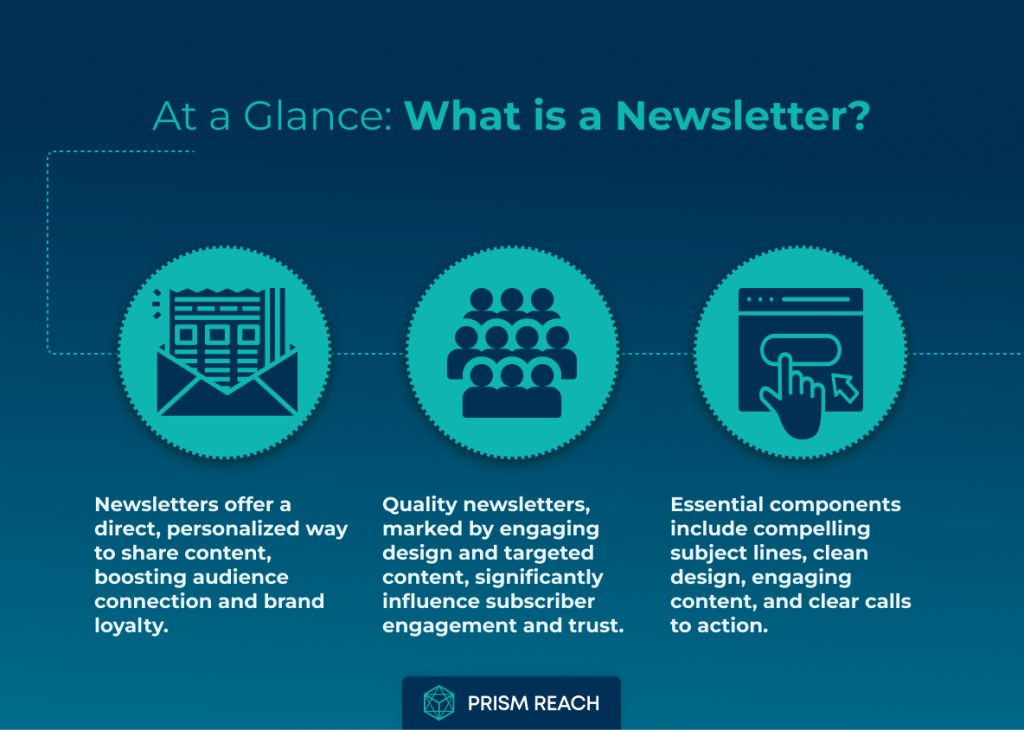
Hidden Gem Strategies for Enhancing Newsletter Effectiveness
While the fundamental principles of email marketing are widely recognized, several lesser-known strategies can significantly enhance the effectiveness of your newsletters. Here are five “hidden gem” strategies that can transform your email marketing campaigns:
1. Leverage User-Generated Content (UGC)
Encourage subscribers to contribute content, such as testimonials, reviews, or photos of them using your products. Featuring UGC in your newsletters can create a sense of community and authenticity.
- Potential Effectiveness: High
- Level of Obscurity: Moderate
- Ease of Implementation: Moderate
- Uniqueness: High
By integrating Prism Reach’s AI capabilities, you can automate the collection and showcasing of UGC, ensuring that the content is relevant and engaging to each subscriber. This not only enhances the visual appeal of your newsletters but also fosters a deeper connection with your audience.
2. Incorporate Interactive Elements
Utilize interactive features like polls, quizzes, or clickable images within your newsletters. This engagement can increase reader interaction and make the content more memorable.
- Potential Effectiveness: High
- Level of Obscurity: High
- Ease of Implementation: Moderate
- Uniqueness: High
Interactive elements can significantly boost engagement rates. Prism Reach can help identify which interactive features resonate most with your audience by analyzing engagement data, allowing you to refine your approach for maximum impact.
3. Segment Your Audience for Tailored Content
Use audience segmentation to send tailored newsletters based on subscriber interests, demographics, or past behavior. Personalized content increases relevance and can improve open and click-through rates.
- Potential Effectiveness: High
- Level of Obscurity: Moderate
- Ease of Implementation: Moderate
- Uniqueness: Moderate
Prism Reach’s advanced segmentation capabilities enable you to categorize your audience efficiently, ensuring that each segment receives content that is most relevant to them. This level of personalization fosters a stronger connection with your subscribers and enhances overall engagement.
4. Utilize Storytelling Techniques
Incorporate storytelling into your newsletters by sharing customer success stories or the journey behind your products. This approach can create an emotional connection with readers.
- Potential Effectiveness: High
- Level of Obscurity: Moderate
- Ease of Implementation: Easy
- Uniqueness: High
Storytelling makes your content more relatable and memorable. Prism Reach can help identify which stories resonate most with your audience by analyzing engagement metrics, allowing you to tailor your narrative strategy effectively.
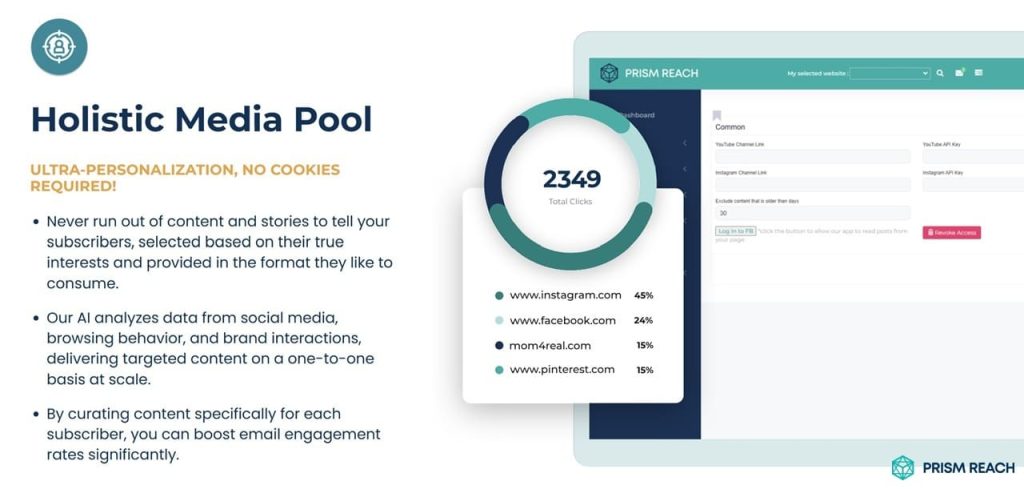
5. Highlight Behind-the-Scenes Content
Give subscribers a glimpse behind the scenes of your business operations, product development, or team activities. This transparency can foster trust and loyalty among your audience.
- Potential Effectiveness: Moderate
- Level of Obscurity: High
- Ease of Implementation: Easy
- Uniqueness: High
Behind-the-scenes content humanizes your brand and builds a stronger connection with your subscribers. Prism Reach can assist in curating relevant behind-the-scenes content by analyzing what aspects of your business your audience finds most engaging.
Best Practices for Creating Effective Newsletters
Creating an effective newsletter involves a combination of strategic planning, engaging content, and leveraging the right tools. Here are some best practices to follow:
1. Know Your Audience
- Understand your target audience’s pain points, interests, and preferences.
- Conduct research and gather data to tailor your content effectively.
- Use surveys or polls to gain direct feedback from your subscribers.
Prism Reach’s user analytics provide deep insights into your audience’s behavior and preferences, enabling you to create content that truly resonates with them.
2. Craft Compelling Subject Lines
- Create subject lines that grab attention and entice readers to open your newsletter.
- Use actionable language, personalization, and a sense of urgency.
- Keep subject lines concise and reflective of the content inside.
A compelling subject line can significantly increase your open rates. Prism Reach’s A/B testing features allow you to experiment with different subject lines to determine which ones perform best with your audience.
3. Maintain Consistent Branding
- Ensure your newsletter aligns with your overall brand identity.
- Use consistent colors, fonts, and logos across all newsletters.
- Reinforce brand recognition and professionalism through design consistency.
Consistent branding in your newsletters reinforces your brand identity and helps build trust with your audience. Prism Reach allows you to maintain consistent branding by providing customizable templates that align with your brand guidelines.

4. Optimize for Mobile Devices
- Ensure your newsletters are responsive and display correctly on all devices.
- Use a single-column layout for better readability on mobile screens.
- Keep content concise and easily scannable for mobile users.
With a significant portion of emails being opened on mobile devices, mobile optimization is crucial. Prism Reach’s mobile-friendly design tools ensure that your newsletters look great on any device, enhancing the user experience for all subscribers.
5. Incorporate Visuals Strategically
- Use high-quality images, infographics, and videos to enhance your content.
- Break up large blocks of text to improve readability and engagement.
- Ensure visuals complement and reinforce your message.
Strategic use of visuals can make your newsletters more engaging and easier to digest. Prism Reach’s content suggestions can help you identify the most impactful visuals to include based on your audience’s preferences.
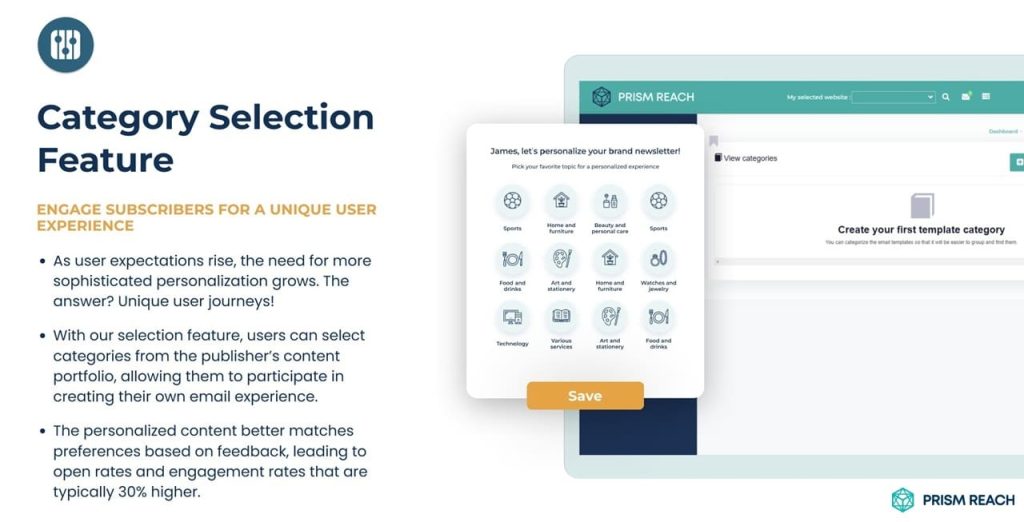
6. Include Strong Calls-to-Action (CTAs)
- Place clear and compelling CTAs that guide readers towards desired actions.
- Use actionable language that encourages immediate response.
- Ensure CTAs are visually distinct and easy to find.
Effective CTAs are essential for driving conversions. Prism Reach can help you design and place CTAs strategically within your newsletters, ensuring they stand out and prompt action from your subscribers.
7. Encourage Interaction and Feedback
- Incorporate interactive elements like polls, quizzes, and surveys.
- Solicit feedback to understand subscriber preferences and improve future content.
- Foster a sense of community and engagement through interactive features.
Encouraging interaction not only boosts engagement but also provides valuable insights into your audience’s preferences. Prism Reach’s interactive tools can help you seamlessly integrate these elements into your newsletters.
8. Use Analytics for Continuous Improvement
- Monitor key performance metrics such as open rates, click-through rates, and subscriber growth.
- Analyze data to identify trends and areas for improvement.
- Use insights to refine your newsletter strategy and enhance effectiveness.
Continuous improvement is key to maintaining the effectiveness of your newsletters. Prism Reach’s comprehensive analytics provide the data you need to make informed decisions and optimize your email marketing strategy over time.
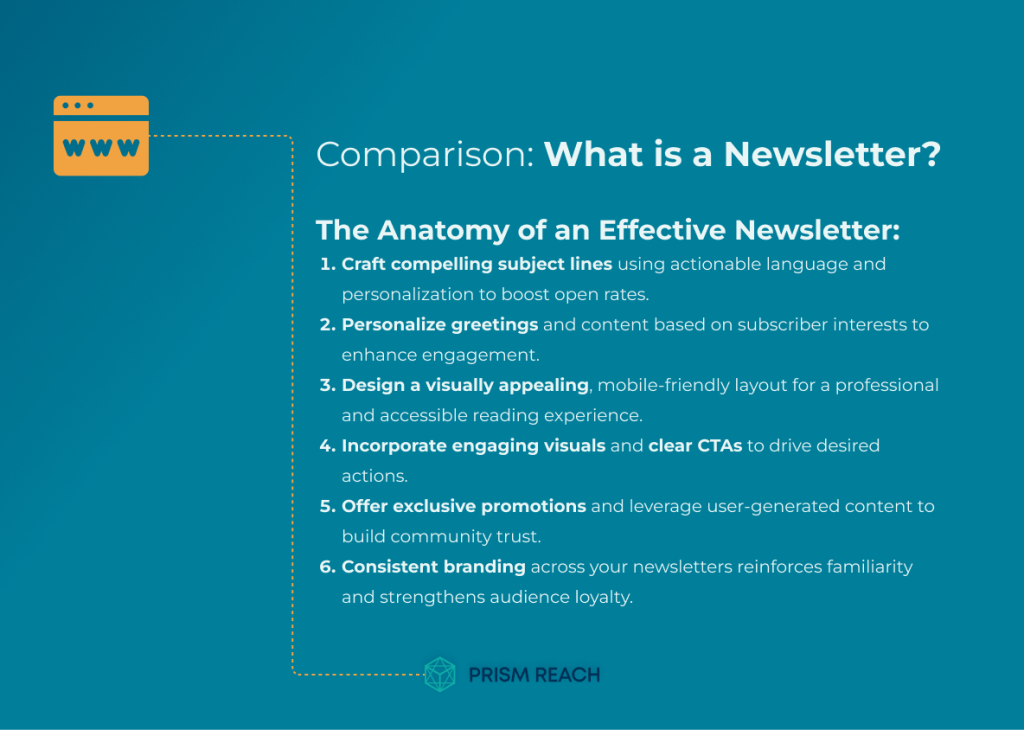
Enhancing Your Newsletters with Prism Reach
While mastering the fundamentals of newsletter creation is essential, leveraging advanced tools like Prism Reach can take your email marketing efforts to the next level. Prism Reach is an innovative AI-powered SaaS solution designed to enhance the effectiveness of email marketing campaigns through deep personalization, advanced analytics, and automated scheduling.
Key Benefits of Prism Reach
- Enhanced Personalization: Prism Reach uses sophisticated AI algorithms to customize every aspect of your email campaigns based on subscriber behavior and preferences, resulting in more engaging and relevant communications.
- Advanced Analytics: Gain deep insights into your email performance with comprehensive analytics, helping you understand what works and where improvements are needed.
- Automated Scheduling: Optimize send times automatically based on predictive analytics, ensuring your emails are delivered when subscribers are most likely to engage.
Prism Reach’s Advanced Features
Prism Reach offers a suite of features designed to streamline and enhance your email marketing efforts:
- AI-Powered Personalization: Clusters content into relevant categories and creates detailed user avatars for highly personalized email content.
- Seamless Setup and Integration: Quick integration within minutes with one-click uploads for existing subscriber lists.
- Dynamic Content Selection: AI determines the most relevant content for each recipient, ensuring your emails are tailored and engaging.
- Automated Proofreading: Identifies and corrects spelling, grammar, and punctuation errors to maintain professionalism.
- Tone Analysis: Assesses the tone of your emails and provides suggestions to ensure your message is clear and respectful.
- Comprehensive Analytics: Tracks email performance metrics, offering insights into open rates, click-through rates, and overall engagement.
Streamlined User Journey with Prism Reach
The typical user journey with Prism Reach involves a streamlined process where you set up your account, import your contact list, and begin crafting personalized email campaigns with the help of AI-driven tools. Subscribers receive tailored messages that resonate with their preferences and behaviors, enhancing their experience and increasing the likelihood of positive interactions.
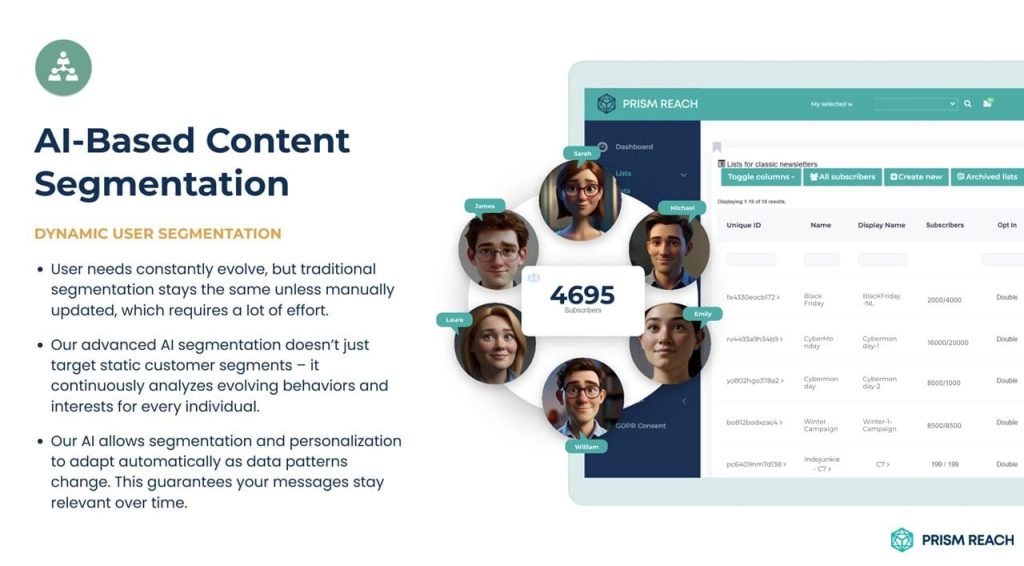
Compliance and Data Privacy
Prism Reach places a strong emphasis on GDPR compliance and hosts data within secure, European servers, adhering to the highest standards of data protection. This focus on privacy is crucial for building trust with your recipients and ensuring that your email communications comply with international regulations.
Future Prospects
Looking ahead, Prism Reach aims to expand its capabilities by integrating more advanced AI features and expanding into new sectors such as eCommerce. The company is committed to continuous improvement, ensuring that its solutions remain at the forefront of email marketing technology and innovation.
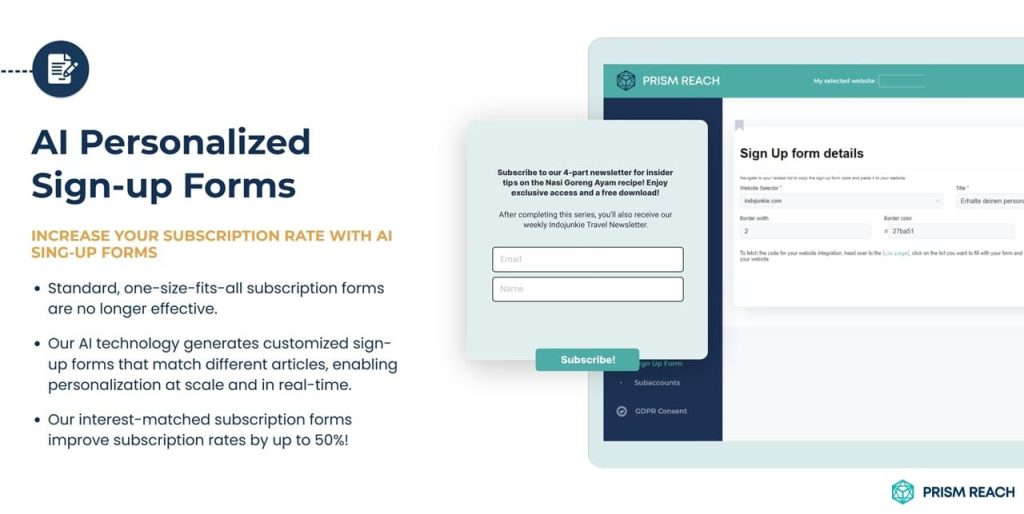
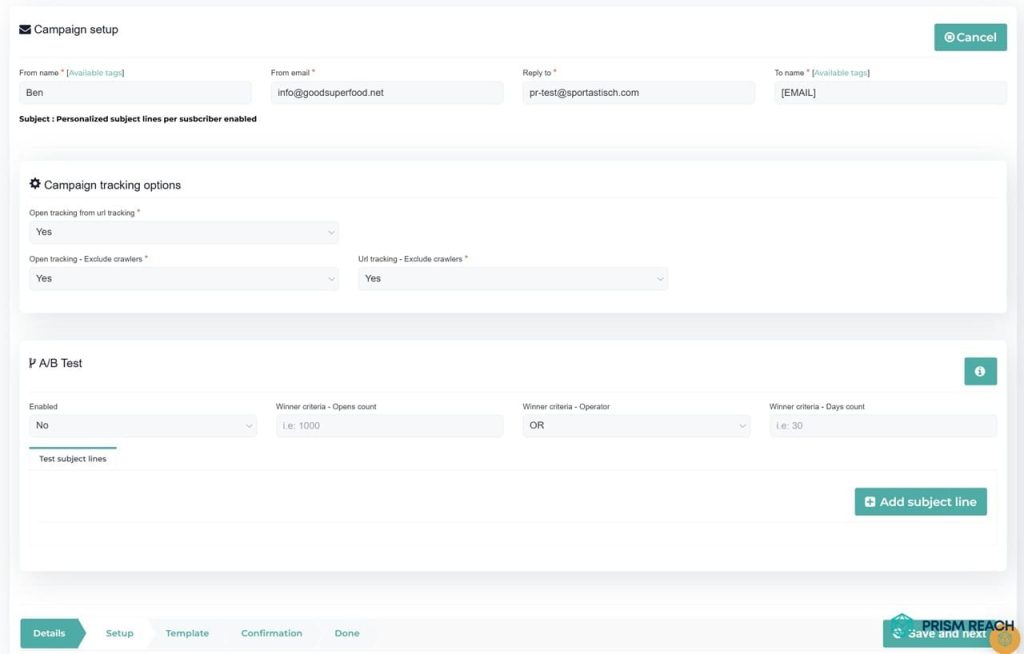
Maximizing Email Marketing Effectiveness with Prism Reach
Email marketing remains one of the most effective channels for nurturing leads, driving conversions, and fostering long-lasting customer relationships. Prism Reach can help you craft compelling email campaigns that resonate with your subscribers, ensuring higher engagement and click-through rates.
Prism Reach Integration Benefits
Integrating Prism Reach into your email marketing strategy offers several benefits:
- Personalized Engagement: Tailor email content to individual subscriber preferences, enhancing relevance and interaction.
- Automated Optimization: Utilize AI to automatically adjust send times and content for optimal performance across devices.
- Data-Driven Insights: Leverage comprehensive analytics to understand email effectiveness and refine your strategies accordingly.
By harnessing these benefits, Prism Reach ensures that your email campaigns are not only visually appealing but also strategically effective in driving engagement and conversions.
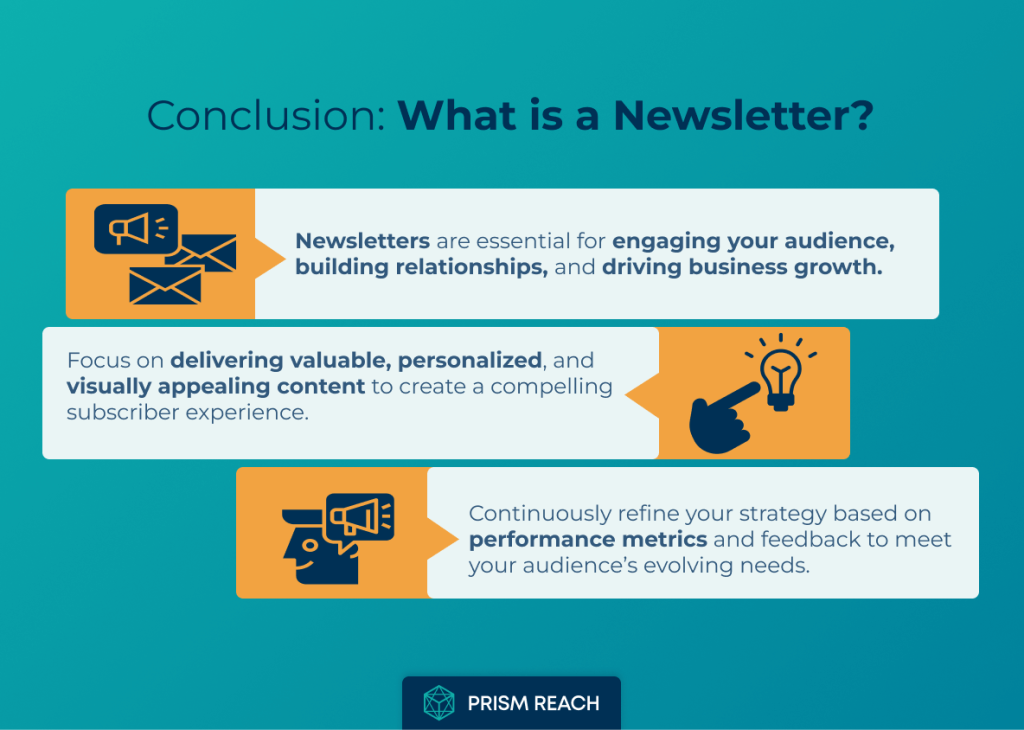
Conclusion
Newsletters are a powerful tool for engaging your audience, building relationships, and driving business growth. By understanding the key elements of an effective newsletter and incorporating personalization, relevant content, and a visually appealing design, you can create a compelling experience for your subscribers.
To maximize the impact of your newsletters, focus on delivering value to your audience consistently. Segment your list, tailor your content, and leverage the power of personalization to create a deeper connection with your subscribers. Continuously test and optimize your campaigns based on performance metrics and subscriber feedback to ensure you’re meeting their evolving needs and preferences.
Prism Reach is particularly recommended for businesses seeking to take their newsletter game to the next level. With its advanced AI capabilities, hyper-personalization features, and seamless integration options, Prism Reach empowers you to create highly targeted and engaging newsletters that deliver results.
Embrace the power of newsletters and unlock the potential of personalized email marketing with Prism Reach. Start creating newsletters that truly resonate with your audience and drive meaningful engagement today.
“On average, 8 out of 10 people will read your headline copy, but only 2 out of 10 will read the rest.” – Brian Clark
Sources
- ActiveCampaign – Newsletter Ideas to Engage Readers
- OptiMonk – Creative Newsletter Ideas
- Mailmodo – Newsletter Ideas for Engagement
- Campaign Monitor – Must-Have Newsletter Ideas
- Klaviyo – Winning Email Newsletter Examples